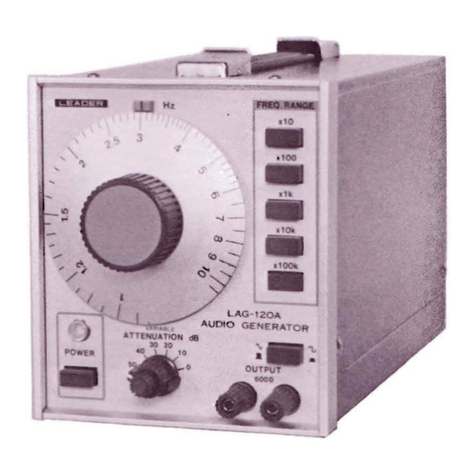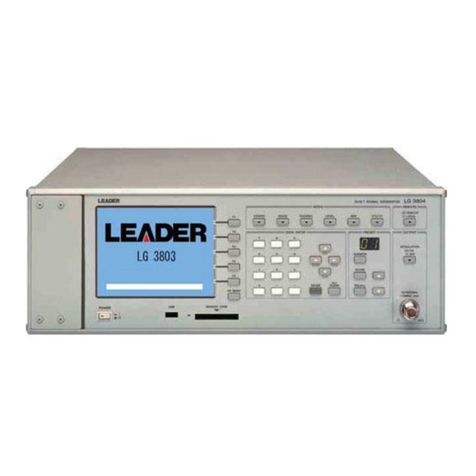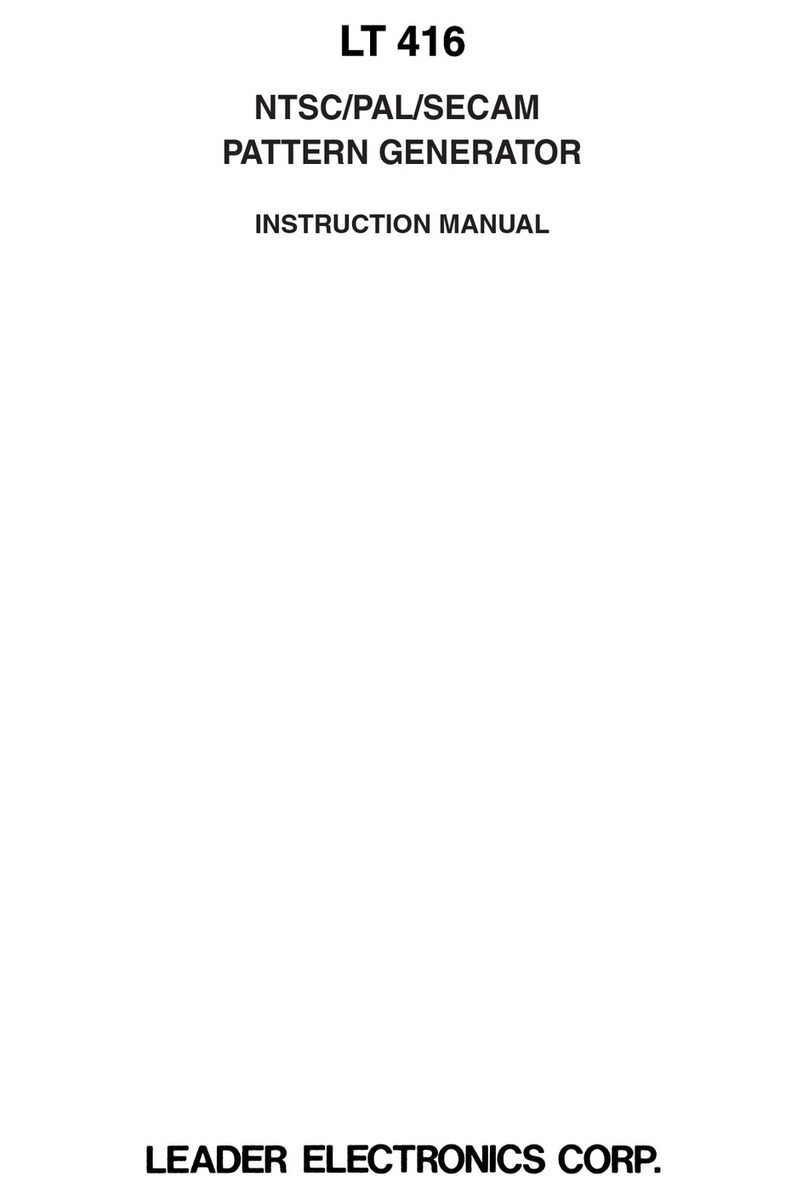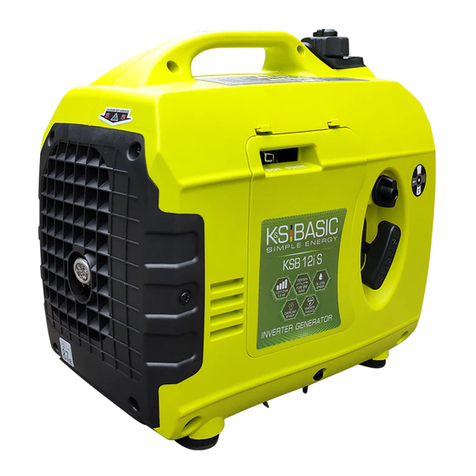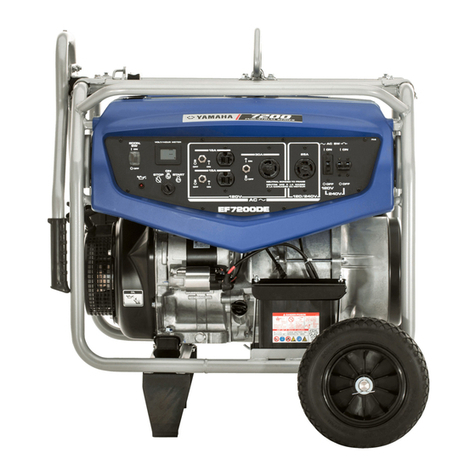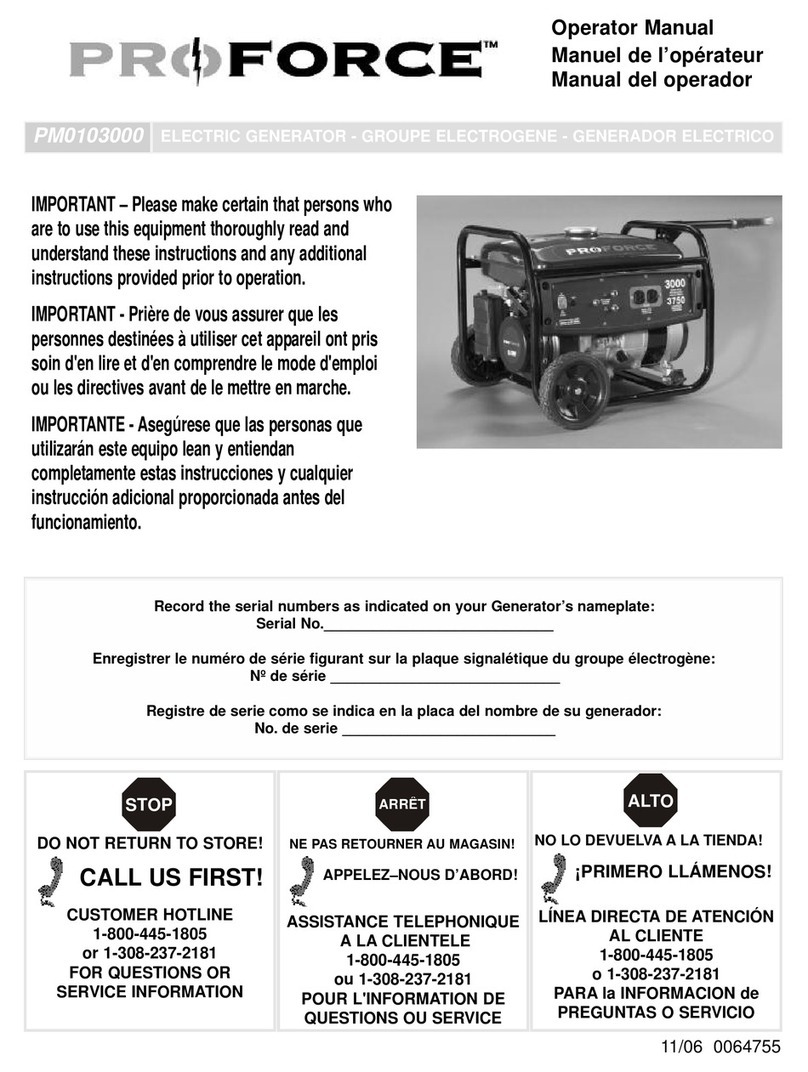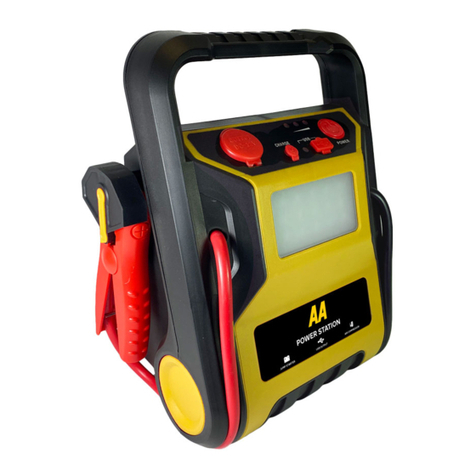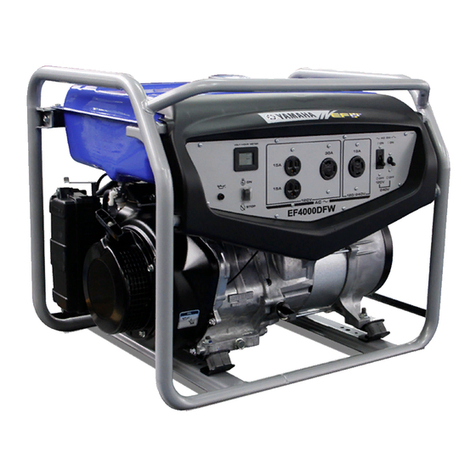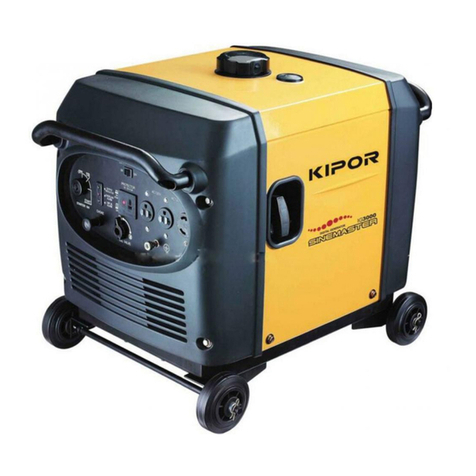Leader Electronics Corp. LSG-17 User manual

"TECHNICAL
FILE"
. .
MODEL
LSG-17
WIDE
BAND
SIGNAL
GENERATOR
lNSTRUCTION
MANUAL.
LEADER
ELECTRONICS
CORP.

Model LSG-17
SIGNAL GENERATOR
TABLE OF CONTENTS
SECTION PAGE
General.
. . . . . . . . . . . . . . . . . . . . . . . . . . . . . . . . . . . . . . 1
1
SPECIFICATIONS.........................
1
2DESCRIPTION 2
2.1 Controls 2
2.2 Circuit
Design.
. . . . . . . . . . . . . . . . . . . . . . . . 3
3OPERATION 5
3.1 Preparation 5
3.2 .Connections 5
3.3
Modulated Carrier, internal
source.
. . . . . . . . . . 6
3.4 Modulated Carrier, external
source.
.......... 6
3.5 Unmodulated Carrier 6
3.6 Crystal Oscillator
Output
. . . . . . . . . . . . . . . . . 7
3.7 AF
Output,
1kHz 7
3.8 Oscillator Frequency Calibration 8
3.9 Removal
of
Chassis from Cabinet 9
3.10
The
Line Voltage Changing. . . . . . . . . . . . . 9
Block Diagram
Schematic

General
LSG-17
is
avery versatile thick film integrated circuit (IC), wide-
band
signal generator designed for
the
radio experimenter, hobbyist,
service technician and instructional purposes. An IC
is
used in astable
oscillator circuit
to
cover the frequency range from 100kHz
to
150MHz
on
fundamentals and
up
to
450MHz on harmonics. Among
the
many
features are
the
large easy-to-read dial marked
at
455kHz and
10.7MHz, one audio frequency for amplitude modulation
or
external
use, provision for crystal oscillator operation. Serves
as
amarker
generator when used with asweep generator in checking and aligning
RF
and
IF
circuits in TV and FM receivers.
SECTION
1
SPECIFICATIONS
Frequency Range
Band
Frequency Accuracy
RF
Output
Output
Control
Modulation
100kHz
to
150MHz (up
to
450MHz on
harmonics)
A100 -300kHz
B
300
1000kHz
C1.00 -3.5MHz
D3.0
-l1MHz
E10 -35MHz
F
32
-- 150MHz (96 450MHz,
calibrated harmonics)
±1.5%
100mVrms, approx.,
up
to
35MHz. (open
circuit)
HIGH-LOW switch and flne adjuster.
Int.: approx. 1kHz 30% ±10%
Ext.:
50Hz-20kHz,
at
less than .15Vrms
(30% ±5%) input.
-1-

Audio
Output
Cyrstal Oscillator
Power Supply
Size and Weight
1kHz; 1Vrms or more (fixed).
For
l-l5 MHz
crystal in Type FT-243
holder. (not included).
100, 115 120, 220 -240V, 50/60Hz;
approx.3VA.
l50(H) X238(W) X80(D) mm; 2.5kg.
SECTION 2
DESCRIPTION
®
2.1 Controls
Frequency dial Sets the
RF
output
frequency in
the range selected with FREQ
RANGE switch.
FREQ RANGE switch With six positions for
RF
output
frequency range.
- 2 -

INPUT-OUTPUT
XTAL socket
POWER switch
Pilot lamp
Mode switch
For
insertion
of
quartz crystal,
1-15MHz,
in Type FT-243 holder.
For
turning
on
the
AC
power.
Indicates when AC power
is
on.
EXT
MOD:
For
modulation
of
carrier with an external source.
INT
MOD:
Use
of
internal 1kHz
for modulation or external cir-
cuit testing.
XTAL OSC: Crystal oscillator out-
put;
frequency depends
on
crys-
tal used.
For
external modulation .input or
output
from internal 1kHz oscilla-
tor.
@FINE control Continuous
RF
output
voltage ad-
juster.
RF
LOW-HIGH switch Sets the
RF
output
level;
at
LOW,
output
is
lowered
by
1/10.
OUTPUT terminals
For
connection to
RF
output
leads.
2.2 Circuit Design
The circuits which compose the LSG-17 will be described
with reference to the functional block diagram and components
designated
on
the schematic.
A.
RF
Circuit.
The
RF
oscillator uses an IC, IC102, in
the
Colpitts
circuit to generate frequencies from 100kHz
to
150MHz
on
fundamentals. The frequency
of
operation
is
set with
the
FREQ RANGE switch and the tuning dial. Calibration
-3-

accuracy
is
better
than
±l.5%.
For
convenience in setting
the
IF
circuit frequencies, tuning scales are marked
at
455kHz
and 10
.7MHz.
The
RF
output
is
controlled with
the
fine adjuster
and
LOW-HIGH switch.
For
amplitude modulation,
the
audio signal
is
sup-
plied
by
the
modulator,
IC101.
The
modulating
is
done
by
varying
the
supply voltage
at
the
audio rate.
B.
AF
Oscillator/Amplifier and Crystal Oscillator.
An
IC,
IC101
is
used for three functions, depending
on
the
positions
of
the
mode switch.
At
EXT
MOD position,
it
serves as an audio amplifier
for
the
external modulation input. The signal from INPUT
is
applied
to
the
IC101
and
on
to
the
modulator.
The
1kHz signal is generated with use
of
the phase-
shift oscillator.
The
output
is
fed
to
the modulator and
OUTPUT (when used externally).
At
XTAL position,
IC101
acts
as
an oscillator when
acrystal,
1-l5MHz,
is
inserted in the XTAL socket.
The
output
is connected
to
the
LOW
terminal
of
LOW-
HIGH
output
switch. The signal
is
available
at
the
OUT-
PUT
connector
at
the
LOW
position.
It
is
possible
to
super-
impose the
RF
oscillator signal on
the
crystal oscillator
output
at
this position.
C.
Power Supply.
ADC voltage
is
supplied from arectifier-ftlter system.
Unregulated voltage at approximately
+20V
is used for
the
IC101
and
IC102
circuits.
IC101
includes regulated DC
power supply. Regulated DC is supplied
to
the
IC101
and
IC102.
4

The
power
transformer T1
01, has
its
primarywindings
with
three taps;100V,
115-120V,
220-240V.
It
is
easy
to
change line voltage.
The LED,
D103
is
connected across
the
+20V
power
supply through
the
RI09.
SECTION 3
OPERATION
3.1 Preparation
(1) Set the POWER switch at OFF.
(2) Connect the AC plug
to
the AC supply.
(3) Connect the
RF
output
leads
to
OUTPUT terminals.
(4) Set the FINE control at center and the
RF
slide switch
at
LOW.
During the tests, this switch is
set·
at
LOW
or
HIGH
as
required.
(5) Set the
FREQ
RANGE switch
at
the operating
band
and
rotate the frequency dial knob
to
set
the
pointer on the
desired frequency.
3.2 Connections
The
RF
leads are connected to
the
input
of
the circuit
under test. The red terminal is at high potential, or
"hot",
and
black is
at
ground potential for chassis connection.
For the
RF
signal
at
the receiver antenna
input,
connect
a50
to
200 ohm resistor, 1/4W,
in
series. When checking sets with
the bar
or
rod
antenna, connect leads
to
acoil with afew turns
of
wire and couple the coil
to
the antenna.
In checking
RF
and
IF
amplifier circuits, connection
should be made through asmall capacitor,
1-5pF,
in
order
to
-5-

prevent detuning effects.
NOTE: When connecting directly
to
the
input
circuit, make
certain
that
there
is
no ,high
DC
voltage present.
Otherwise, connect ablocking capacitor,
0.05 uF
-100
pF, depending on the frequency.
3.3 Modulated Carrier, internal source
Set the mode switch at INT. MOD.
By tuning the receiver
to
the generator frequency,
or
vice
versa, an audio
tone
will be heard in
the
loudspeaker. An audio
voltmeter should be connected across the speaker terminals when
aligning the internal circuits. A
dummy
resistor with suitable
power rating can
be
used in place
of
the moving coil curing
the measurements.
It
is advisable
to
keep
the
RF
signal level
as
low
as
possible
in order
to
prevent overloading the transistors or
IC
in the circuit.
Excessive
input
voltage will cause AGC action
and/or
two
resonance points
to
appear and proper alignment
or
adjustment
is
impossible.
3.4 Modulated Carrier, external source
Set the mode switch at EXT, MOD.
Connect leads from an external audio generator
to
the
INPUT.
Frequencies
up
to
20kHz can be used for modulation.
The
audio
input
voltage should
not
exceed 0.5V; this is
to
pre-
vent
modulation distortion.
3.5 Unmodulated Carrier
Set the mode switch at EXT. MOD. There should be no
connection
to
the INPUT.
6

The
RF
signal can be used in testing areceiver equipped
with a
beat
oscillator,
or
circuits
that
do
not
require amodulated
signal.
The
RF
signal can be applied
to
asweep generator for the
marker signal.
3.6 Crystal Oscillator
Output
Control settings:
Mode switch
at
XTAL. Insert acrystal, in FT-243 holder,
in the XTAL socket.
RF
output
switch
at
LOW.
FREQ
RANGE switch
at
"F"
and frequency dial at
150MHz.
FINE control
at
minimum.
The
output
signal is
treated
in the same manner
as
for
the
unmodulated carrier
with
the
exception
that
the
output
level cannot be adjusted.
In certain calibration procedures ashort lead near
the
test circuit will provide sufficient coupling.
NOTE:
If
the
RF
signal is required at the same time, set
the
output
frequency with the
FREQ
RANGE switch
and frequency dial
as
required. Adjust
the
RF
FINE
control.
3.7
AF
Output, 1kHz
Control settings:
Mode switch at INT. MOD.
FREQ
RANGE switch
at
"F"
and frequency dial
at
150MHz.
Connect leads from OUTPUT to the test circuit. Use
an
external potentiometer,
100k-1M,
to
lower
the
voltage.
- 7

3.8
Oscillator
Frequency
Calibration
The
RF
oscillator frequency can be calibrated
to
ahigh
degree
of
precision using
the
harmonics
of
the
internal crystal
oscillator
and
an external all-wave receiver. The
latter
is
utilized
as
afrequency transfer unit. I
(1) Set
the
mode
switch at XTAL.
(2) Insert
the
"standard
frequency" crystal, preferably at
amultiple
of
1MHz.
For
spot
frequency checking,
at
say
10.7MHz, use a10.7MHz crystal.
(3)
Set
the
RF
slide switch
at
LOW.
Adjust
the
FINE
control
as
required.
(4)
Connect
the
RF
output
to
the receiver
input,
direct
or
through
asmall coupling capacitor
to
the
rod
antenna.
(5) In
the
following example, use
of
a1MHz crystal will be
given.
(6) Tune
the
receiver
to
5MHz,
or
5th
harmonic
of
IMHz.
Then by carefully tuning
both
the oscillator and receiver,
an audio
beat
will be heard. The oscillator
is
adjusted
to
zero
beat
and
the dial reading
is
noted.
At
other
frequen-
cies spaced 1MHz apart, the same procedure
is
repeated,
namely, oscillator setting tuning the receiver retuning
oscillator and noting the reading on the dial.
Practical use
of
harmonics
up
to
the
tenth
or higher
is
possible. However, care must be exercised
in
selecting
the
proper harmonic, especially at high
RF
when arela-
tively low frequency crystal
is
used.
NOTE: When areceiver equipped with a
beat
frequency
oscillator
is
used, the measurements can be sim-
plified. The
"zero-beat"
condition
is
at
the
point
where the steady
beat
is
heard
most
clearly.
8

3.9 Exposing
the
chassis
The chassis can be exposed in the following manner for
inspection:
(1) Loosen one screw
at
front
part
of
top
cover.
(2) Remove
one
screw
on
the
bottom
side.
(3) Remove
one
screw
at
the
back.
(4)
Take
off
the
cover.
3.10
The Line Voltage Changing
This
instrument
can
be
oper-
ated
from
AC
line sources
of
100V,
115V
-120V
or
220V
-240V.
The
Line Voltage Selector
(pin
connector
with plastic cover)
allows one
of
three voltages
to
be
selected.
Fig. 3-1
115~
120V
lOOV
9

To
select the desired line
voltage, proceed
as
follows:
(1) DISCONNECTTHE INSTRU-
MENT FROM THE POWER
SOURCE,
(2) Remove screw
on
the right
side of
the
instrument then
take the cover off. (Ref:
Fig. 3-1)
(3) Move
the
Line Voltage
Se-
lector
to
the desired voltage
position. (Ref: Fig. 3-3)
LINE VOLTAGE SELECTOR
Fig. 3-2
Block diagram
AF
IN/OUT
IC
102
OUT
ONLY
SIG
SELECT
I
C101
XTAL.

Table of contents
Other Leader Electronics Corp. Portable Generator manuals
Popular Portable Generator manuals by other brands
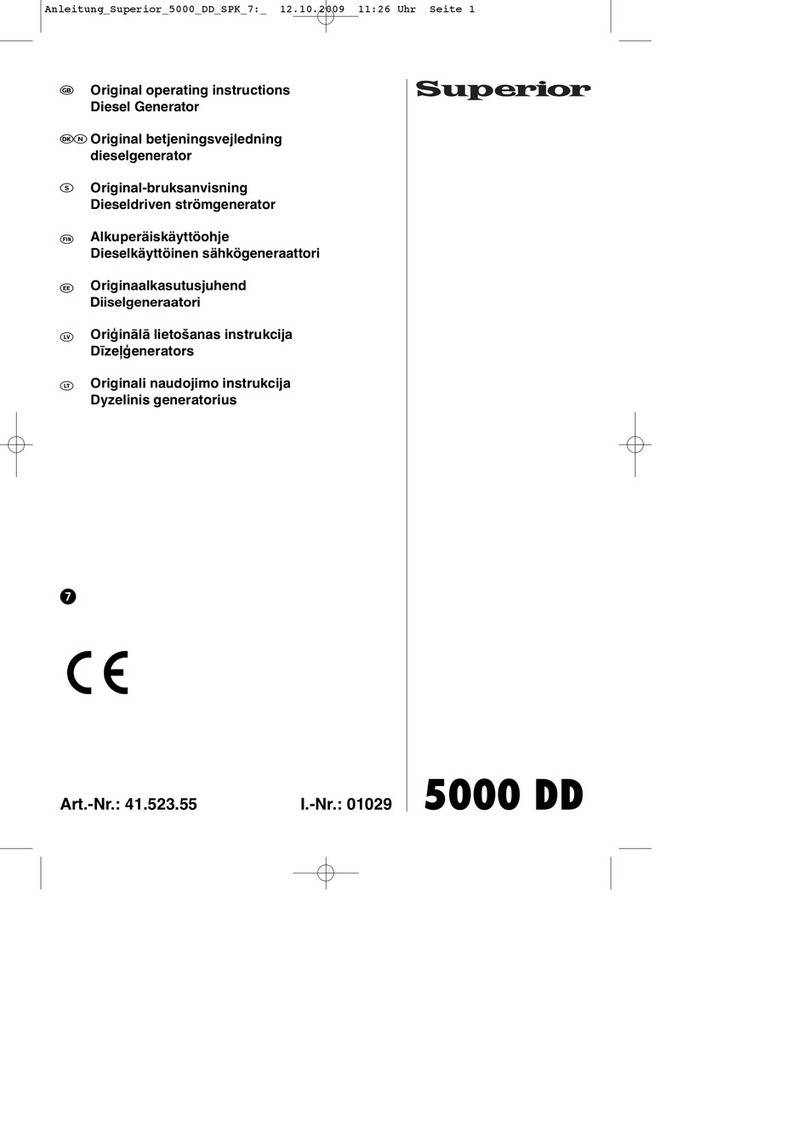
Superior
Superior 5000 DD Original operating instructions
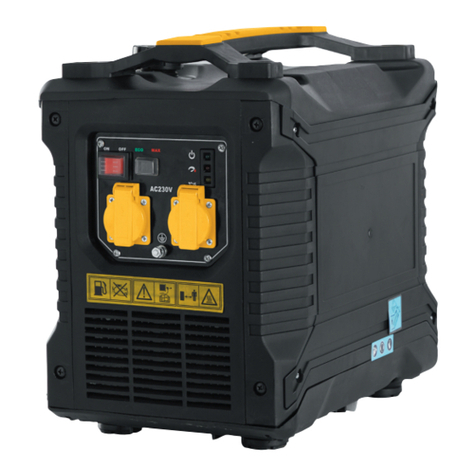
Probuilder
Probuilder 18065 instruction manual

Yanmar
Yanmar mase Marine I.S. 5.0 Workshop manual

DUROMAX
DUROMAX XP5500EH user manual
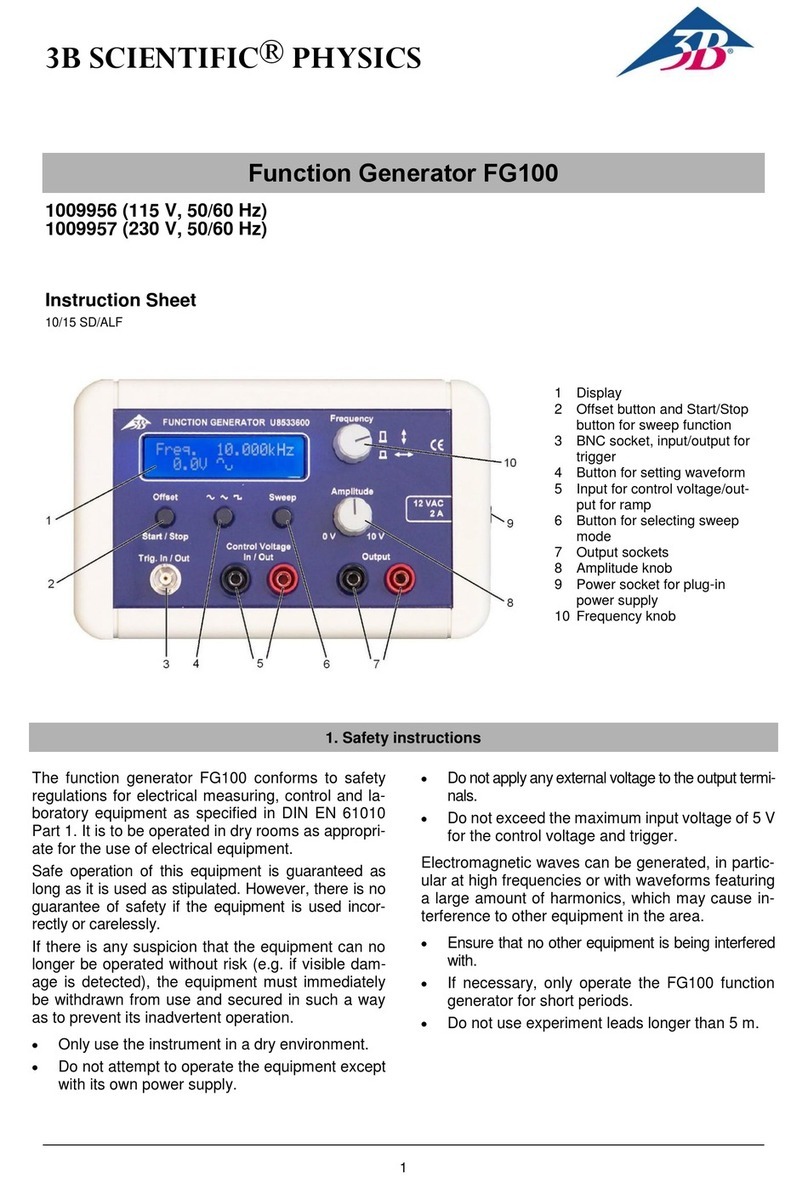
3B SCIENTIFIC PHYSICS
3B SCIENTIFIC PHYSICS FG100 instruction sheet

Atlas Copco
Atlas Copco QAS 14 Kd S5 ESF instruction manual
